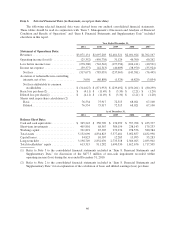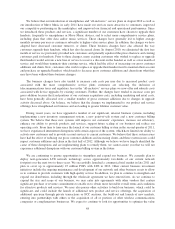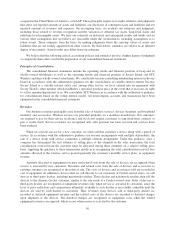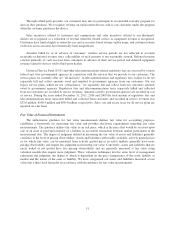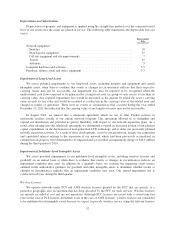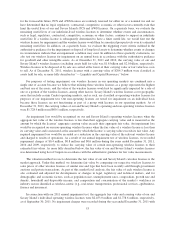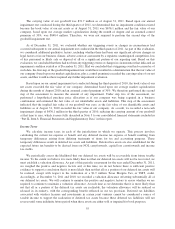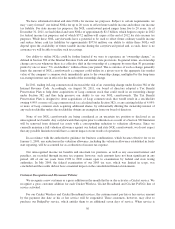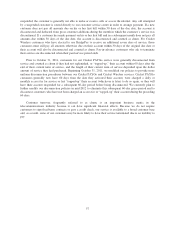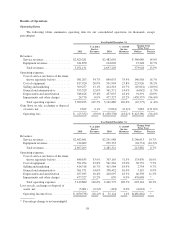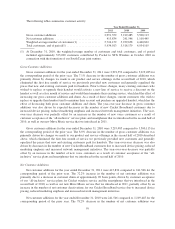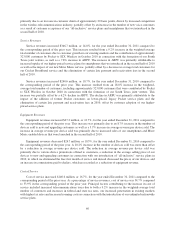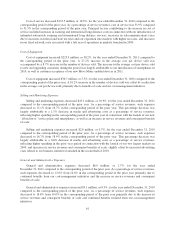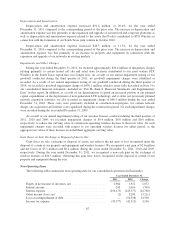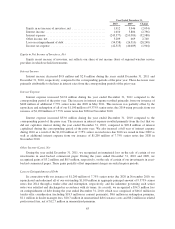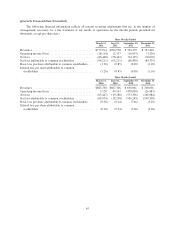Cricket Wireless 2011 Annual Report Download - page 66
Download and view the complete annual report
Please find page 66 of the 2011 Cricket Wireless annual report below. You can navigate through the pages in the report by either clicking on the pages listed below, or by using the keyword search tool below to find specific information within the annual report.We have substantial federal and state NOLs for income tax purposes. Subject to certain requirements, we
may “carry forward” our federal NOLs for up to 20 years to offset future taxable income and reduce our income
tax liability. For state income tax purposes, the NOL carryforward period ranges from five to 20 years. As of
December 31, 2011, we had federal and state NOLs of approximately $2.5 billion, which begin to expire in 2022
for federal income tax purposes and of which $37.2 million will expire at the end of 2012 for state income tax
purposes. While these NOL carryforwards have a potential to be used to offset future ordinary taxable income
and reduce future cash tax liabilities by approximately $973.6 million, our ability to utilize these NOLs will
depend upon the availability of future taxable income during the carryforward period and, as such, there is no
assurance we will be able to realize such tax savings.
Our ability to utilize NOLs could be further limited if we were to experience an “ownership change,” as
defined in Section 382 of the Internal Revenue Code and similar state provisions. In general terms, an ownership
change can occur whenever there is a collective shift in the ownership of a company by more than 50 percentage
points by one or more “5% stockholders” within a three-year period. The occurrence of such a change generally
limits the amount of NOL carryforwards a company could utilize in a given year to the aggregate fair market
value of the company’s common stock immediately prior to the ownership change, multiplied by the long-term
tax-exempt interest rate in effect for the month of the ownership change.
In 2011, trading in Leap common stock increased the risk of an ownership change under Section 382 of the
Internal Revenue Code. Accordingly, on August 30, 2011, our board of directors adopted a Tax Benefit
Preservation Plan to help deter acquisitions of Leap common stock that could result in an ownership change
under Section 382 and thus help preserve our ability to use our NOL carryforwards. The Tax Benefit
Preservation Plan is designed to deter acquisitions of Leap common stock that would result in a stockholder
owning 4.99% or more of Leap common stock (as calculated under Section 382), or any existing holder of 4.99%
or more of Leap common stock acquiring additional shares, by substantially diluting the ownership interest of
any such stockholder unless the stockholder obtains an exemption from our board of directors.
None of our NOL carryforwards are being considered as an uncertain tax position or disclosed as an
unrecognized tax benefit. Any carryforwards that expire prior to utilization as a result of a Section 382 limitation
will be removed from deferred tax assets with a corresponding reduction to valuation allowance. Since we
currently maintain a full valuation allowance against our federal and state NOL carryforwards, we do not expect
that any possible limitation would have a current impact on our results of operations.
In accordance with the authoritative guidance for business combinations, which became effective for us on
January 1, 2009, any reduction in the valuation allowance, including the valuation allowance established in fresh-
start reporting, will be accounted for as a reduction of income tax expense.
Our unrecognized income tax benefits and uncertain tax positions, as well as any associated interest and
penalties, are recorded through income tax expense; however, such amounts have not been significant in any
period. All of our tax years from 1998 to 2010 remain open to examination by federal and state taxing
authorities. In July 2009, the federal examination of our 2005 tax year, which was limited in scope, was
concluded and the results did not have a material impact on the consolidated financial statements.
Customer Recognition and Disconnect Policies
We recognize a new customer as a gross addition in the month that he or she activates a Cricket service. We
recognize a gross customer addition for each Cricket Wireless, Cricket Broadband and Cricket PAYGo line of
service activated.
For our Cricket Wireless and Cricket Broadband services, the customer must pay his or her service amount
by the payment due date or his or her service will be suspended. These customers, however, may elect to
purchase our BridgePay service, which entitles them to an additional seven days of service. When service is
56


